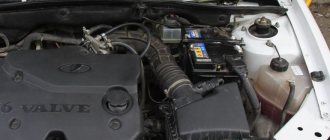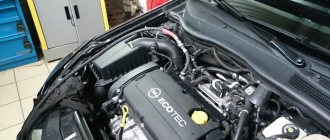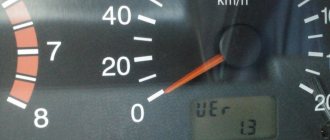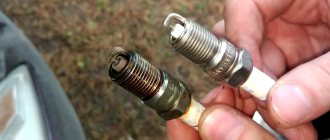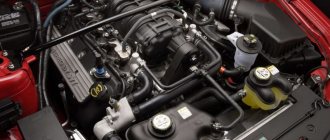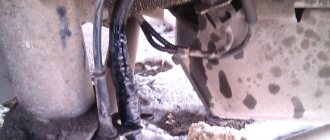Antifreeze or antifreeze is a working fluid that is designed to circulate in the circuit of the engine liquid cooling system. An insufficient level of coolant (coolant), a significant loss of its properties, air entering the system and other malfunctions lead to the fact that the engine does not operate at the optimal temperature for the power unit.
We also recommend reading the article about the difference between antifreeze and antifreeze. From this article you will learn about the main differences between these types of coolant for the cooling system.
An antifreeze leak is a common problem that requires immediate attention. The fact is that even a minor leak can suddenly develop into a serious leak. As a result, the engine can quickly overheat, which leads to serious consequences for the motor. For this reason, it is important to find the location of the leak and eliminate the antifreeze leak in the cooling system. In this article, we will look at where antifreeze can leak from, talk about how to find an antifreeze leak, and also answer the question of how to fix leaks.
How does the engine cooling system work?
Any passenger vehicle is equipped with a cooling system. The volume of the liquid heater contained is usually within ten liters. Either antifreeze or antifreeze acts as a “coolant”. The liquid element heats up during operation.
The temperature range of normal functioning in the Northern regions is minus forty degrees, and the highest limit is plus one hundred degrees.
Despite the significant difference in temperature, the volume of antifreeze increases by five to ten percent.
This indicates the need for reserve capacity to ensure the simultaneous performance of not one, but several functions:
- Excess liquid flows into the radiator device for cooling;
- The system operates under closed conditions at appropriate pressure. When liquid coolant enters the reservoir, the layer of air is compressed, along with an increase in pressure. In this case, the plug is squeezed out. To avoid this, a compressed volume of air is expelled through the valve;
- When the liquid cools, it flows from the reservoir simultaneously with the air supply from outside. Such conditions are created so that vacuum does not occur in the pipes and an air lock does not form.
The tank is a container closed with a plastic lid. It can be any shape. The lid is equipped with a bypass valve. It ensures air or steam exchange during the boiling of antifreeze.
In what places does antifreeze leak most often?
- Places for crimping rubber pipes with clamps. Due to numerous temperature changes, vibrations and often poor-quality composition, rubber products tend to dry out and crack. Antifreeze leaks appear near metal clamps. At the same time, the greatest destructive effect on rubber hoses is exerted by overtightened “Soviet” type clamps. Many of them, when tightened, damage the pipe with the sharp edges of the clamping mechanism. Diesel fuel, gasoline, and motor oil that get on them also have a negative impact on the safety of rubber products of the cooling system.
On cars with pre-installed gas equipment (LPG), you should first look for leaks in the places where the hoses are connected to the gas reducer, as well as on the tees. With their help, gas workers tear the standard engine cooling jacket to supply coolant to the gearbox.
- Cracks in plastic pipes and thermostat housing. On some cars, leakage of the thermostat and individual plastic products is a design feature that happens to almost all engines of the defective series. In other cases, the breakdown is most often caused by unskilled repairs, in which parts are tightened with too much force, as a result of which the plastic cracks.
- Leaking engine cooling radiator. More often, the radiator leaks through the plastic casing and through the honeycombs, which are damaged when stones get into them.
- Insufficient tightness of the rubber seals used to seal the seats of the thermostat insert and coolant temperature sensor (DTOZ). To eliminate the leak, it is necessary to clean the seat and replace the rubber seal.
- External damage to the heat exchanger and connecting metal tubes. A heat exchanger leak in the body appears due to external mechanical influences during the repair process or due to corrosion of the cooler walls. Heat exchanger corrosion often occurs due to the use of low-quality antifreeze. The above also applies to connecting metal pipes, which are often located in very unfavorable places in the engine compartment.
List of possible problems
Antifreeze leaking out of the reservoir means the presence of a faulty element. In this case, the leak may be clearly visible, or it may be hidden.
It can happen like this:
- Through the plug in the tank, the liquid substance is thrown out. In this case, drips form both near the cap and on the walls of the expansion tank. In dry weather, it will not be difficult to detect a characteristic wet spot under the car;
- Leaks may also appear in other places. For example, at connections, in pipes, in the main radiator device or pump;
- Leaks appearing in invisible places. For example, the heater radiator in the cabin could have leaked, or the gasket under the cylinder had suddenly burned out.
If you were unable to independently determine the cause of the leak, then you should take advantage of the capabilities of in-depth diagnostics. In rare cases, it is necessary to disassemble the entire system.
The problem may also be in the cabin. The condition of the radiator can be checked after removing the decorative panels. The liquid may well drip onto the floor after splashing through the stove radiator.
It is difficult to notice because of the rug, but the smell will always make itself known. It is unpleasantly sweet, and the resulting greasy streaks are quite difficult to clean.
You may also be interested
Why the interior may smell like antifreeze: several serious reasons
Many motorists have encountered the unpleasant situation of smelling antifreeze in their car. Why is this happening? How dangerous is the situation for the car and its owner, how to fix the problem? Let's talk to the experts.
Why did the antifreeze in the expansion tank darken and become cloudy?
Understanding why the mixture may darken will help you identify and correct the problem in time. This phenomenon may indicate mixing of the refrigerant with other functional fluids, and this is always a consequence of breakdowns. But even if the antifreeze has simply darkened, without other symptoms, it definitely needs to be replaced.
Causes of breakdowns
Basically, in practice, it comes down to contamination or jamming of the valve on the cover. Then, not finding a way out, the air under pressure forces the antifreeze to knock out the weakest part of the structure. Most often it turns out to be either a pipe joint or a plug thread.
When. If the valve simply does not close, then there is a constant conflict between the atmosphere and the system, in which more steam is produced than necessary.
The leak is not visible, and the antifreeze level drops noticeably. The difficulty is that the leak does not indicate itself in any way.
In addition, the reasons may be as follows:
- If the cap valve malfunctions, a crack often forms through which antifreeze flows out;
- The liquid composition gets out if the pump seal malfunctions. Then it can be seen both on the belt and on the cylinder block;
- Radiator leak when corrosion has occurred or damage has occurred from mechanical impact;
- If the gasket between the cylinders and the head is burned out, then gases will seep through the resulting microscopic cracks, which, expanding over time, can connect chambers and channels with water and oil.
How to determine a leak if there are no visible leaks?
In many of the cases described above, you may not see any antifreeze leaks in the engine compartment. If the leak is located near the exhaust system, small leaks will quickly evaporate. Many of the areas of the engine cooling water jacket are located in hard-to-reach places, making their visual inspection impossible.
A striking example of such a defect is an antifreeze leak in the cylinder block camber, found on 3 liter diesel engines from VW/Audi (CRCA/CASA and their relatives).
The luminescent additive greatly facilitates the search for leaks. The composition with a fluorescent admixture stands out in contrast under the rays of ultraviolet light, which makes it possible to detect leaks among oil fogging and traces of other technical fluids.
Some manufacturers include a luminescent additive in the antifreeze composition. If the coolant in your car's engine cooling system does not have such a useful property, you can add a UV additive yourself. Similar formulations are produced by Liqui Molly, Tracer Products (TP-3900 Dye-Lite) and many other brands. To find a leak, you will need to purchase or make your own ultraviolet lamp.
How to fix a breakdown yourself
Repairs should always be preceded by preliminary diagnostics. First, the cause is clarified, and then the problem with antifreeze leakage is eliminated.
Problems in practice are usually resolved in one of the following ways:
- If the plug valve malfunctions, it is simply cleaned. It may even need to be replaced, which is quite expensive;
- If the tank bursts, then it is replaced with a new one or, at a minimum, soldered;
- Hoses are replaced if there is a leak in them. Only in case of bottom leakage, you can simply trim them a little;
- A hole in the pump seal requires replacing not only it, but also the water pump;
- A detected problem in the radiator allows repair work to be carried out. Service workers can check that the resulting cracks are not due to corrosion;
When a cylinder head gasket breaks, it is changed immediately, since it is impossible to use a car with such a breakdown.
If the problem is discovered during a trip, it is recommended to add water to the system. This is done in order to be able to get to the nearest service center. Except in cases of gasket burnout. Then the only way out is to call a tow truck.
Remedies
Before starting repairs, you should figure out where and why the antifreeze is leaking, that is, make a diagnosis. Leaking hoses are easy to identify, as are fluid emissions from the tank - colored streaks are visible in the area of the lid. It’s more complicated with radiators - the holes in the pipes are usually small, they are blown by an air flow as they go, and leaks are invisible at first glance.
Advice. Fill the car's cooling system with antifreeze containing a fluorescent additive. It reflects the light of an ultraviolet lamp, making the slightest drips clearly visible.
Various problems can be resolved in the following ways:
- Try to clean and rinse the faulty valve of the expansion tank plug. If this does not help, the part should be replaced; it is inexpensive.
- A burst tank should be replaced. There is a practice of repairing plastic containers by soldering, but this option is not very reliable - the body may crack with the next pressure surge.
- Leaking hoses are definitely replaced. The exception is a crack at the very end, then the pipe is trimmed (if the length allows).
- A leaky pump seal must be replaced only on old Zhiguli VAZ 2101–07. On other cars it is replaced together with the water pump.
- Car radiators can be repaired if the cracks in the honeycombs are not the result of corrosion of the aluminum alloy. In any case, the unit must be removed and taken to a service center for inspection.
- A broken cylinder head gasket must be replaced immediately; you cannot drive with this damage. The work involves disassembling the engine; it should be entrusted to a master mechanic.
